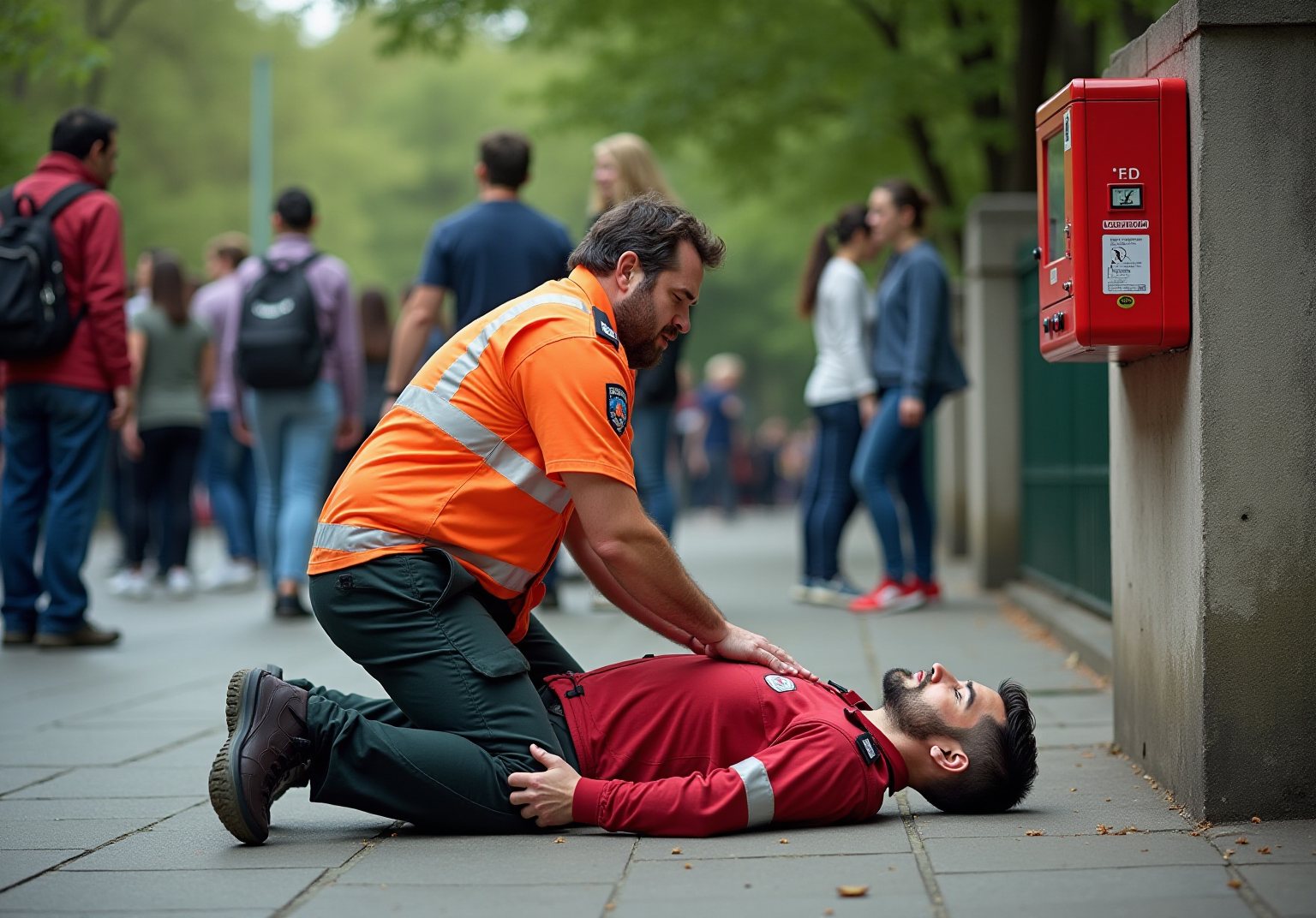


Cardiac arrest is a critical medical emergency that occurs suddenly, marked by the abrupt cessation of heart activity. This leads to a loss of consciousness and breathing, creating an urgent need for immediate intervention. It's important to understand that prompt care, such as CPR and defibrillation, can make a significant difference in survival rates. With each passing minute without action, these rates decline, highlighting the necessity of recognizing symptoms early on. By understanding the underlying causes of cardiac arrest, we can better prepare ourselves to respond effectively in such situations.
In addition to this, we encourage everyone to familiarize themselves with the signs of cardiac arrest. It’s natural to feel anxious about health concerns, but knowing what to look for can empower you to act swiftly. Remember, your awareness and readiness can save a life. Furthermore, if you or a loved one experiences any concerning symptoms, please don’t hesitate to seek help. We are here to support you every step of the way, ensuring you feel valued and cared for during these challenging moments.
Cardiac arrest is a critical medical emergency that can strike without warning, often leaving bystanders feeling confused and fearful. It is essential to understand this condition, as it involves the sudden cessation of heart activity, leading to halted blood flow and a life-threatening situation.
With the stark reality that nearly 90% of out-of-hospital cardiac arrests result in fatalities, recognizing the symptoms and knowing how to respond is vital.
How can we prepare ourselves to act decisively in such a dire event? What steps can we take to improve survival rates? Together, we can explore these important questions and find ways to equip ourselves with the knowledge and skills needed to make a difference.
Cardiac failure is a sudden and alarming event, often raising the question of what's cardiac arrest, which is marked by the immediate cessation of heart activity, halting blood flow. This unexpected condition often leads to the question, 'what's cardiac arrest?' as it arises from an electrical malfunction within the heart, hindering its ability to pump blood effectively. In such moments, when a person loses awareness and stops breathing, it raises the question of what's cardiac arrest, highlighting the gravity of the situation and the urgent need for medical assistance.
Without prompt care, such as cardiopulmonary resuscitation (CPR) and defibrillation, the risk of death in situations where someone experiences what's cardiac arrest significantly increases. For every passing minute without action, the likelihood of recovery diminishes by approximately 10%. In the United States, over 356,000 out-of-hospital heart failures occur each year, with nearly 90% resulting in fatalities. Recent statistics reveal that the survival rate to hospital discharge after an out-of-hospital heart incident stands at around 10%. This stark reality highlights the critical importance of swift action.
Understanding this definition and the urgency of what's cardiac arrest is vital. It serves as a reminder of the need for immediate intervention. If you or someone you care about experiences symptoms of heart failure, please do not hesitate to seek help. Your awareness and prompt action could make all the difference in a life-threatening situation. Remember, you are not alone; support is available to guide you through these challenging times.
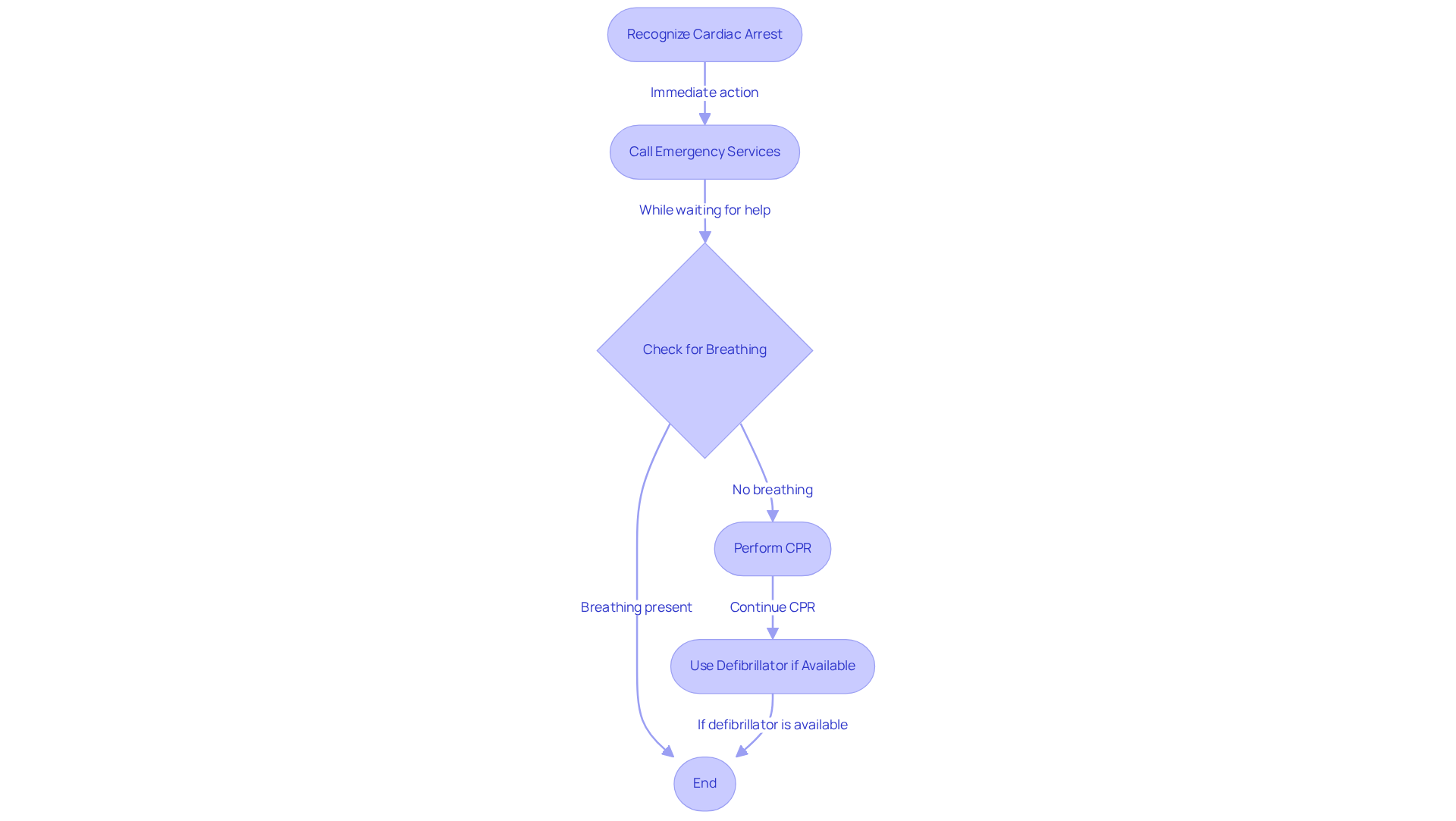
The signs of heart failure can emerge suddenly and can be quite alarming, particularly for those at higher risk, such as individuals with diabetes, hypertension, or a family history of heart issues. Key indicators to watch for include:
Recognizing these signs is crucial, as immediate action can significantly improve survival chances. Many individuals who experience heart failure show one or more signs within the hour leading up to the incident, highlighting the importance of staying aware. If you find yourself in a situation where someone is showing these symptoms, remember that bystanders trained in CPR, such as through the TAKE10 program, can make a vital difference. This program emphasizes the importance of acting quickly—calling emergency services and starting CPR can be lifesaving.
In fact, those who seek medical assistance for warning signs are five times more likely to survive a heart failure event. At Amavita Heart and Vascular Health, we integrate advanced imaging capabilities and comprehensive evaluations into our care plans, specifically designed to benefit high-risk patients and those with inconclusive standard testing. Testimonials from emergency responders further reinforce the need for community awareness and preparedness, reminding us that recognizing these symptoms and acting promptly can truly save lives. We are here to support you and ensure that you feel valued and cared for in every step of your health journey.
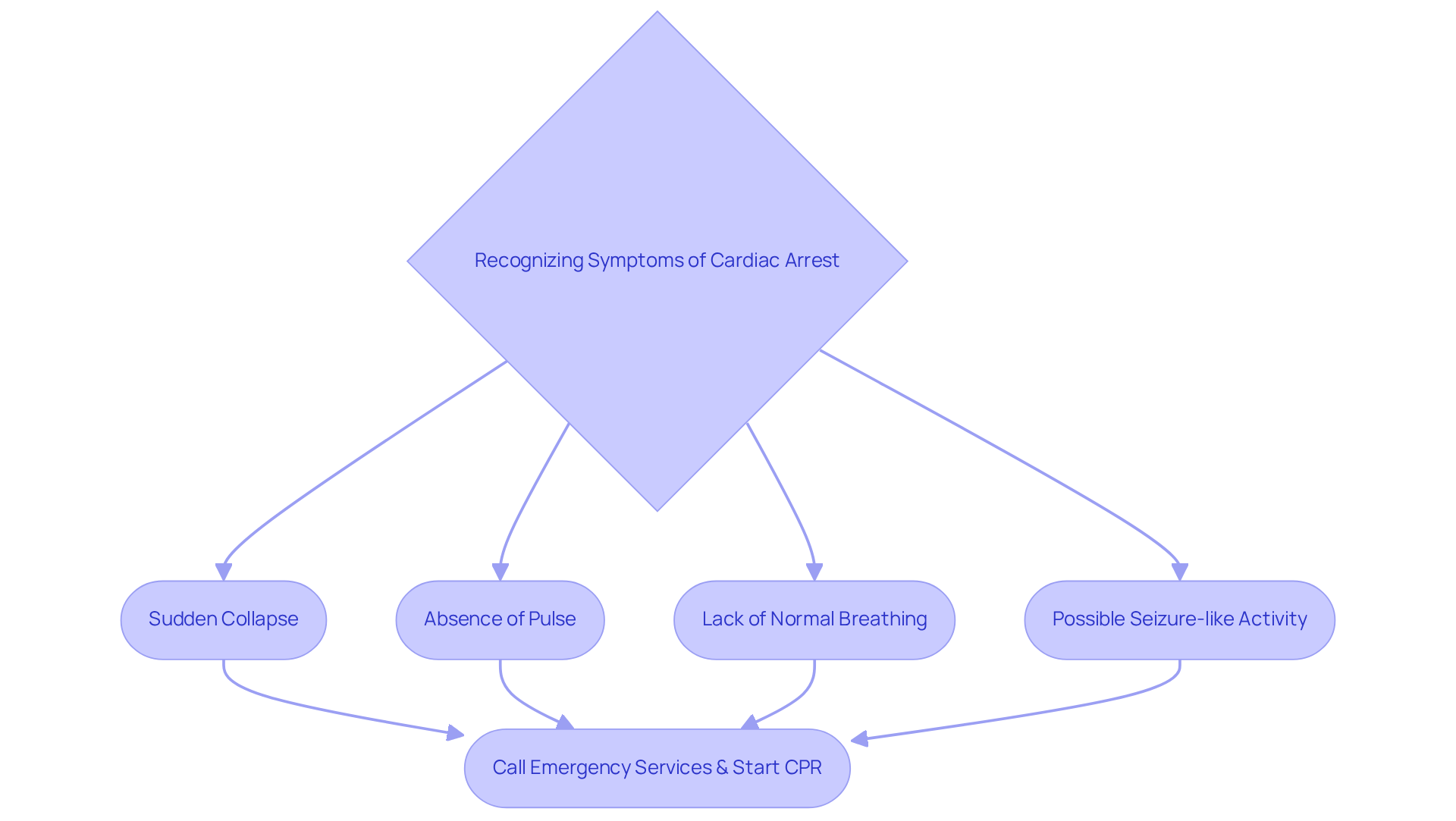
Understanding what's cardiac arrest and the variety of factors that can trigger it can help us identify individuals at risk and take preventive measures.
Coronary artery disease is the leading cause of what's cardiac arrest. This condition involves the narrowing or blockage of arteries, which reduces blood flow to the heart. It’s concerning to note that approximately 70% of sudden heart-related deaths are attributed to this condition.
Another important factor to consider is what's cardiac arrest, particularly in relation to arrhythmias. Irregular rhythms of the heart, especially ventricular fibrillation, are key factors in understanding what's cardiac arrest and the sudden cessation of blood circulation. Many patients with heart failure have underlying arrhythmias that can be life-threatening, highlighting the need for awareness and monitoring.
Structural cardiovascular conditions, such as cardiomyopathy and valvular cardiovascular disease, can significantly elevate the risk of what's cardiac arrest. Unfortunately, these structural issues often go undiagnosed until they lead to severe complications, making it essential to stay vigilant about heart health.
Moreover, electrolyte imbalances can disrupt the heart's electrical signals, leading to potentially fatal arrhythmias. Maintaining proper levels of potassium and magnesium is vital for cardiovascular health, underscoring the importance of regular check-ups.
Lastly, lifestyle factors such as smoking, obesity, and physical inactivity are significant risk factors for heart failure. Fortunately, these adjustable risk factors can be managed through lifestyle modifications. By making positive changes, we can help postpone the onset of coronary artery disease and lower the risk of cardiac failure.
Understanding these causes is crucial, and we encourage you to reach out for support. Together, we can take steps towards a healthier heart.
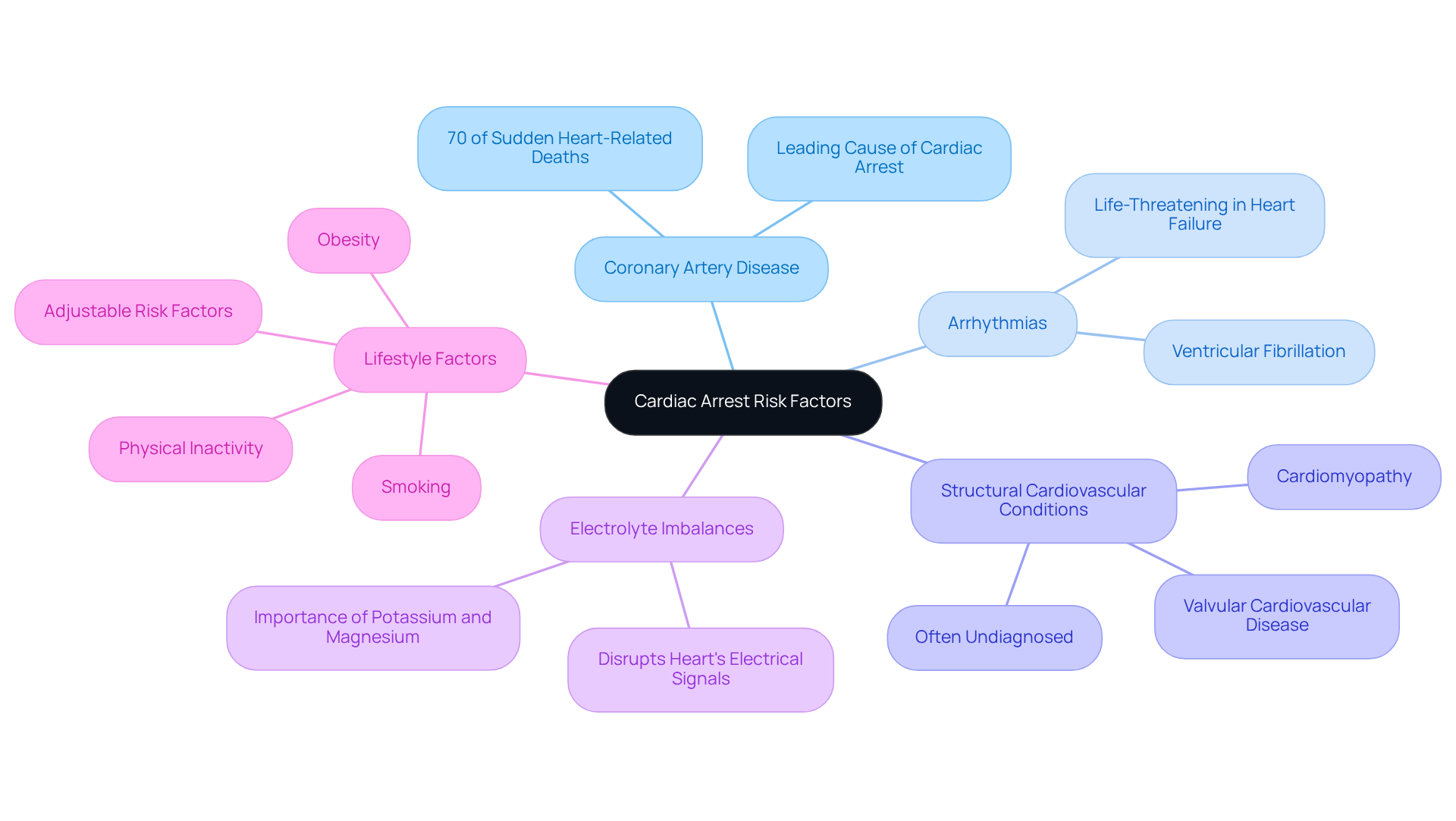
Cardiac failure and myocardial infarction are often confused, yet they represent distinct medical emergencies. A cardiac event occurs when blood circulation to a part of the heart is blocked, typically by a blood clot, causing damage to the muscle tissue. Common symptoms include:
In contrast, heart failure is caused by an electrical malfunction in the heart, which raises the question of what's cardiac arrest, ultimately leading to a complete stop of its beating. During a heart failure episode, which is often described as what's cardiac arrest, a person may suddenly collapse, lose consciousness, and show no pulse or breathing.
Recognizing these differences is crucial for effective emergency response, including knowing what's cardiac arrest. For instance, taking prompt action during a heart emergency, such as administering CPR and using an AED, can significantly increase the chances of recovery when considering what's cardiac arrest. Studies show that performing CPR can double or even triple a person's likelihood of survival. However, it is important to note that while myocardial events can lead to sudden cessation of heart function, not all of them result in immediate heart failure.
At Amavita Heart and Vascular Health®, we emphasize the importance of thorough heart assessments and preventive measures to reduce the risk of heart attacks. Our approach includes:
This ensures that individuals are equipped with the knowledge and resources to act swiftly in emergencies. We provide accurate diagnoses without delay through advanced imaging and testing, offer minimally invasive treatments that often require only local anesthesia, and enable same-day recovery, allowing patients to return home just hours after their procedure. Understanding these nuances can empower individuals to respond appropriately, ultimately saving lives and enhancing cardiovascular care.
Are you or a loved one concerned about heart health? We are here to support you every step of the way, ensuring that you feel informed and cared for.
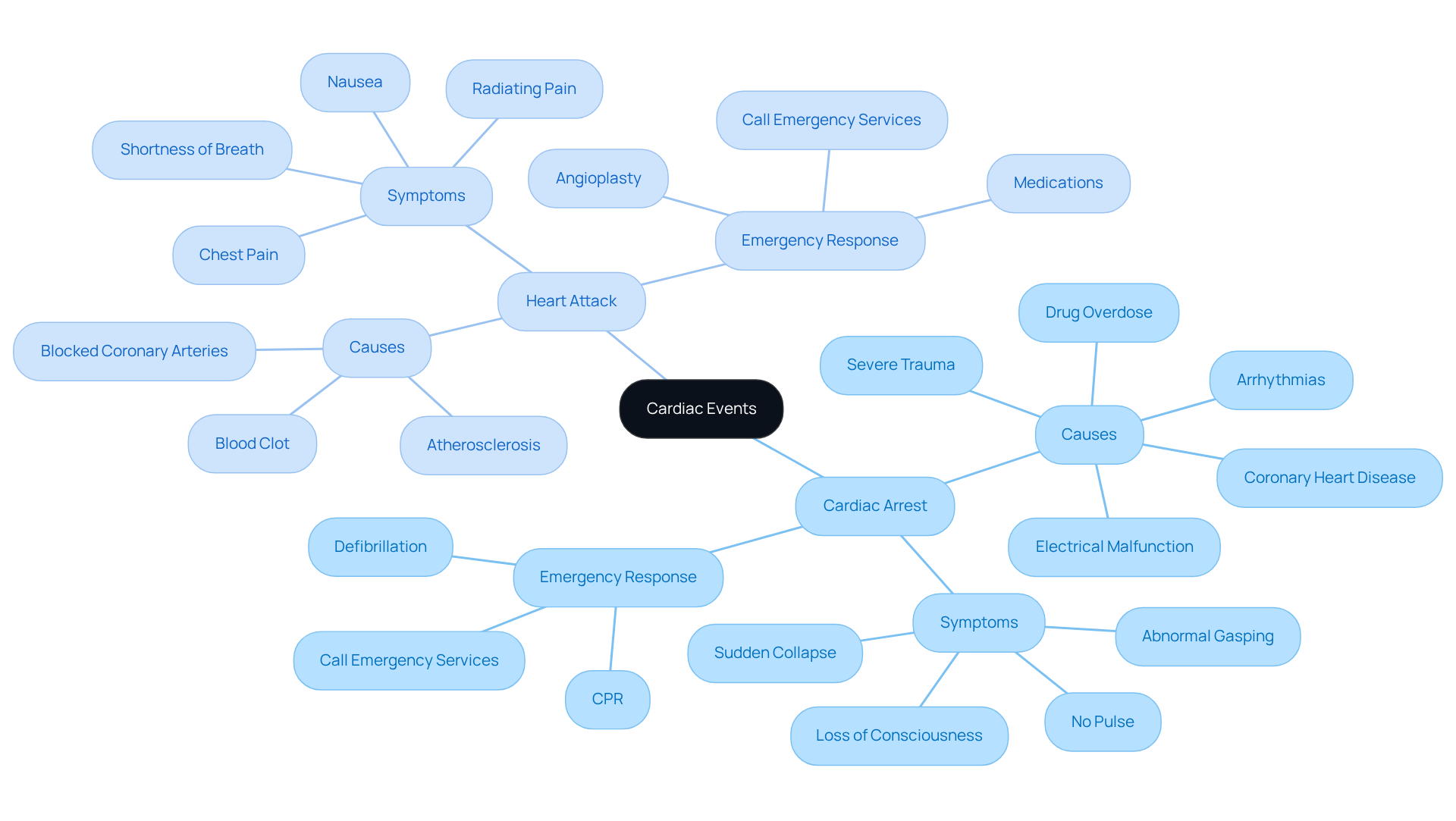
Immediate treatment for cardiac arrest involves several key steps that can make a significant difference in outcomes:
Long-term care may include:
Understanding both immediate and long-term treatment options is vital for improving survival rates and quality of life after cardiac arrest. Our innovative and patient-centered care is designed especially for high-risk patients, ensuring that you feel supported every step of the way. Remember, you are not alone in this journey; we are here to help you navigate through it with compassion and expertise.
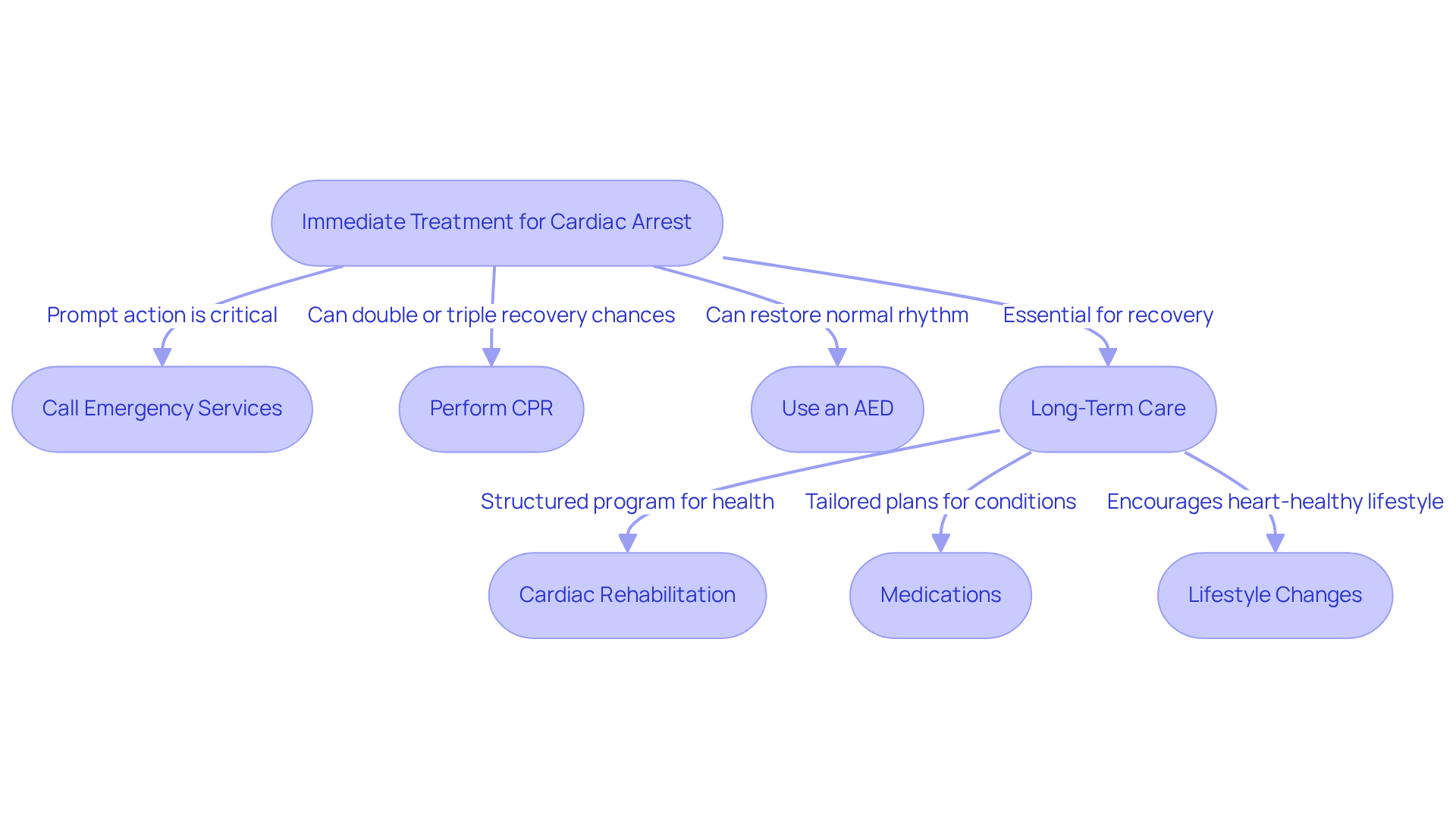
Cardiac arrest is a critical medical emergency that requires our immediate attention and understanding. By grasping its definition, symptoms, and causes, we can better prepare ourselves to respond effectively in life-threatening situations. Recognizing this condition is of utmost importance, as swift action can truly mean the difference between life and death.
In this article, we have outlined key points, including the importance of recognizing symptoms such as:
Understanding the causes—ranging from coronary artery disease to lifestyle factors—highlights the need for proactive health measures. Furthermore, distinguishing between cardiac arrest and heart attacks is crucial for an appropriate emergency response, as each condition necessitates a specific approach. Emphasizing immediate treatments like CPR and the use of AEDs can significantly enhance survival rates and outcomes.
Ultimately, awareness and education surrounding cardiac arrest are vital. We encourage everyone to familiarize themselves with the signs and symptoms, as well as the necessary actions to take in an emergency. By fostering a community of informed and prepared individuals, we can greatly improve the chances of survival. Taking the time to learn about cardiac health and being ready to act can save lives—every second counts when it comes to cardiac arrest. Remember, you are not alone in this; together, we can make a difference.
What is cardiac arrest?
Cardiac arrest is a critical medical emergency characterized by the sudden cessation of heart activity, leading to halted blood flow. It results from an electrical malfunction within the heart, preventing it from pumping blood effectively.
What happens during cardiac arrest?
During cardiac arrest, a person loses awareness and stops breathing. This condition requires immediate medical assistance, as the risk of death increases significantly without prompt care, such as CPR and defibrillation.
How quickly does action need to be taken during cardiac arrest?
For every minute that passes without action, the likelihood of recovery diminishes by approximately 10%. Immediate intervention is crucial for survival.
What are the statistics regarding out-of-hospital cardiac arrests in the U.S.?
In the United States, over 356,000 out-of-hospital cardiac arrests occur each year, with nearly 90% resulting in fatalities. The survival rate to hospital discharge after an out-of-hospital heart incident is around 10%.
What are the key symptoms of cardiac arrest?
Key symptoms of cardiac arrest include sudden collapse or loss of consciousness, absence of a pulse or heartbeat, lack of normal breathing (which may appear as gasping), and possible seizure-like activity due to oxygen deprivation in the brain.
Who is at higher risk for cardiac arrest?
Individuals at higher risk for cardiac arrest include those with diabetes, hypertension, or a family history of heart issues.
How can bystanders help in a cardiac arrest situation?
Bystanders trained in CPR can make a vital difference. It is important to call emergency services and start CPR immediately, as those who seek medical assistance for warning signs are five times more likely to survive a heart failure event.
What resources are available for individuals at risk of cardiac arrest?
Organizations like Amavita Heart and Vascular Health provide advanced imaging capabilities and comprehensive evaluations for high-risk patients. Community awareness and preparedness are also emphasized to help recognize symptoms and act promptly.